MXA’S 2015 KTM 250SXF MOTOCROSS TEST: THE REV RANGER
Q: FIRST AND FOREMOST, IS THE 2015 KTM 250SXF BETTER THAN THE 2014 KTM 250SXF?
A: Yes. KTM focused on refining the 250SXF for 2015, with an eye on decreasing weight (nearly a 1-pound savings) and improving the suspension. These updates are enough to push the 2015 model past the previous iteration.
Q: WHAT’S THE BIG NEWS ABOUT THE 2015 KTM 250SXF?
A: KTM unveiled the first 250SXF four-stroke in the middle of the 2005 model season. Every year since then, KTM has dealt with a suspension package that has never impressed the MXA wrecking crew. The WP forks were plagued by mid-stroke harshness so severe that we would wake up in cold sweats from nightmares of racing the 250SXF. KTM dropped their no-link design in 2011 and joined the linkage bandwagon, but link or no link, the shock was never the problem; it was always the setup of the WP forks.
There seems to be a disconnect between the powers that be at WP and the American motocross racer. The Austrians were pleased with the suspension performance of the WP units, which were tuned for European circuits. American racers were not pleased with the suspension performance of the WP units—and hadn’t been for a decade.
KTM USA was hoisted on their own petard—if they were blindly loyal to WP, they would suffer in the showrooms. If they went against WP’s preferred setup, which would be the same old, same old, they would be biting the hand that feeds them. What to do? Who to please? Luckily for American racers, KTM USA chose to chart their own path with an all-new 4CS fork. The new fork is tested, developed and spec’ed for American riders and tracks. As for European riders, they get the old WP bladder forks again.
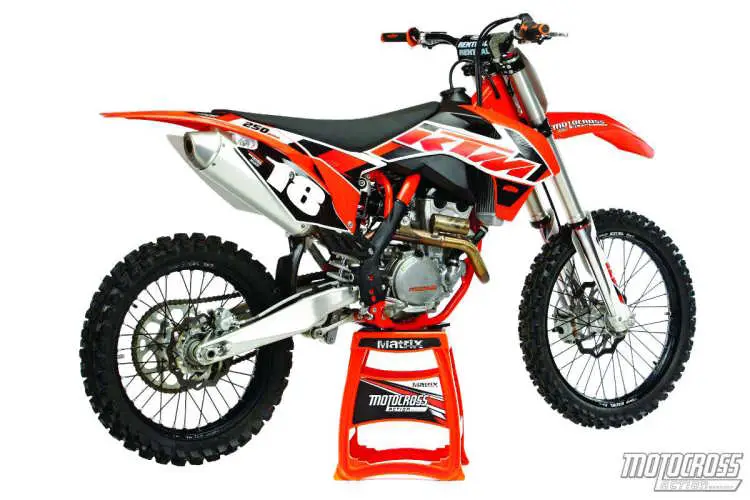
Q: HOW DOES THE WP 4CS FORK WORK?
A: The 4CS (Four Chamber System) fork is comprised of four uniquely distinct chambers. The left fork leg contains the compression damping, while the right leg controls the rebound damping with adjustment dials on top of the fork caps. This design allows for simple, virtually on-the-fly adjustments. Additional benefits of the 4CS fork include improved damping and lighter overall weight.
How does the four chamber work? Read on.
Outer tube chamber. The outer tube chamber contains the main spring and air chamber. This is the same design in both fork legs, except that the left leg houses the compression damping, while the right leg is responsible for the rebound damping. The advantage of keeping the spring in a separate chamber is that changing spring rates is considerably easier than with a traditional system. A bleed screw on each fork cap can release built-up air pressure from the outer chamber. The main spring guide rotates inside the top cap and allows the fork spring to rotate for decreased friction and binding within the fork.
Inner chamber. The inner chamber contains the cartridge, as well as a sealed chamber full of oil. With the old WP closed-cartridge fork, it was possible to force oil out of the air-bleed screw hole in order to lessen mid-stroke harshness. That’s no longer possible, given that the 4CS chamber is sealed. The oil level is now determined based on the weight of the fork leg rather than by measuring oil height.
Cartridge chamber. The cartridge chamber is found inside the inner chamber, which is where damping is created. The cartridge chamber houses the piston that plunges through the oil.
Reservoir chamber. Found at the bottom of the upper fork tube (in the same area where the fork seal is located) is the extension reservoir chamber. It creates an optimum pressure balance in the fork and prevents cavitation. The reservoir is available to accept displaced oil from the inner chamber as the fork is compressed. The reservoir chamber contains the reservoir body, a short pressure chamber spring, separator piston and circlip.
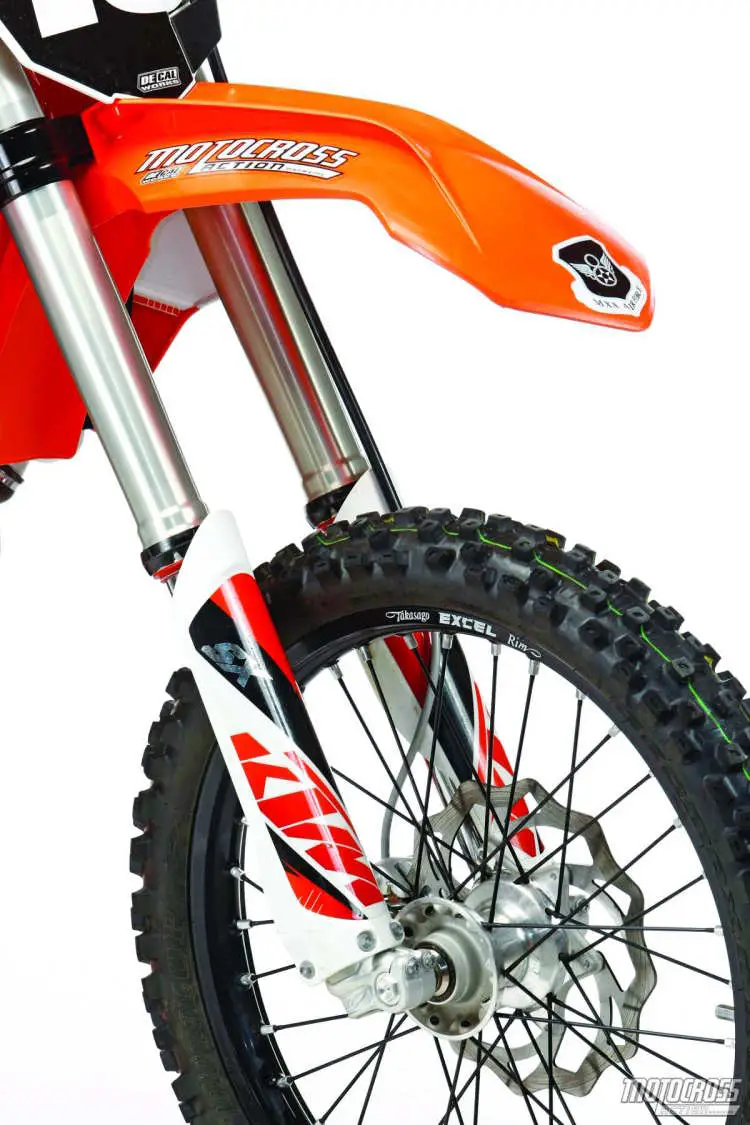
Q: WHAT OTHER CHANGES WERE MADE TO THE 2015 KTM 250SXF?
A: The list is not extensive. KTM feels content with their 250SXF package, making minimal changes to problem areas rather than rebuilding from the ground up. This approach to refining a motorcycle has many redeeming qualities. (a) The engineers can focus on key issues rather than starting over from scratch. (b) Good attributes of the bike aren’t lost to the dumpster in pursuit of unproven ideas.
Here is the list of significant 2015 KTM 250SXF changes:
(1) Frame. Borrowed from the 2014 KTM 450SXF Factory Edition, the 2015 KTM 250SXF receives a machined cross tube to connect the frame sides and the shock linkage. Previously a chromoly tube with welded tabs, it has been replaced by a forged-steel piece that reduces flex and weight (60 grams). It also provides exact tolerances for improved performance. The most obvious change on the new 250SXF is the orange powdercoated frame.
(2) Front axle. KTM reduced the front axle size by 4mm (from 26mm to 22mm) to reduce weight by 40 grams. The axle offset has been adjusted from 35mm to 33mm to increase trail for better stability.
(3) Fork guards. Gone are the wraparound fork guards. In their place are lighter and smaller guards with in-mold graphics. They don’t offer as much protection as the previous design, but are 50 grams lighter.
(4) Shock. The WP 5018 shock and linkage package features a new machined linkage called the “G” linkage by KTM; it is the exact spec as what the factory race bikes run. It features a revised rising rate that has a higher starting rate that blends into a flatter, less progressive curve. The new pull rod is 2.5mm longer and 26 grams lighter. It lowers the seat height by 8mm. The shock features an increase of 4mm of shaft travel while maintaining the same amount of wheel travel. Lastly, the shock has been re-valved to match the fork and chassis package. There is less low-speed compression and more high-speed compression, with the clickers making a more noticeable difference.
(5) Triple clamp. KTM’s black-anodized four-position triple clamps have a new O-ring support for the lower bearing on the steering stem. It is made of aluminum and 22 grams lighter. The steering-stem bolt is 8 grams lighter, thanks to a decrease in head-nut size (downsized from 27mm to 17mm).
(6) Wheels. Gone are the silver Excel rims; in their place are black-anodized Excel rims with black spokes and silver aluminum nipples. KTM also shaved 50 grams off the rear sprocket. Dunlop Geomax MX52 tires come stock.
(7) Clutch. New O-rings are used on the oil-pump suction screen for increased durability. The clutch basket has been revised for improved durability and weight savings, while the clutch springs are designed to be more consistent under stress over time.
(8) Additional updates. The KTM 250SXF comes standard with Renthal 827-bend Fatbars, but the new Domino grips feature a softer dual-compound design. Additionally, the bike is outfitted with new in-mold graphics.
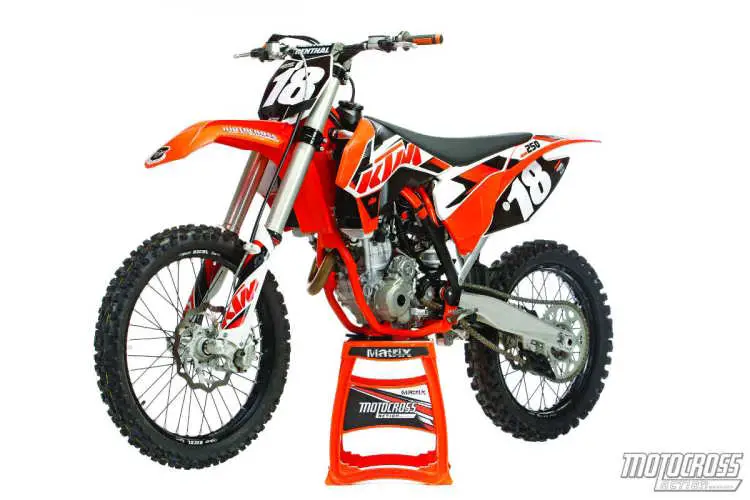
Q: WHAT CHANGES WERE WE HOPING THAT KTM WOULD MAKE TO THE 2015 KTM 250SXF?
A: Here are the two key areas holding the 2015 KTM 250SXF back from world domination:
(1) Engine. We hoped that KTM would finally address the elephant in the room. For many years the MXA wrecking crew has begged KTM to produce a 250 four-stroke powerband that appeals to their American audience. That didn’t happen. KTM’s target consumer is an Expert-level racer. This strategy is wrong for two reasons. (a) The cream of the motocross crop already spends thousands of dollars on engine work to make their stock bikes as fast as possible. KTM’s 250SXF is fast out of the crate, but it won’t remain in stock trim in the hands of a Pro. (b) Although motocross celebrates those fearless individuals who set the fastest lap time at their local track, the vast majority of riders are at the Novice- and Vet-level speed. They don’t want a high-rpm missile that requires you to rev it to 14,000 rpm and never shut off. The 2015 KTM 250SXF powerband is too tough to keep on the pipe for those who live from 8000 to 11000 rpm. There is a reason why Americans love the KX250F and YZ250F powerbands—it’s because they aren’t anything like the KTM 250SXF powerband.
(2) Gearing. The MXA wrecking crew has hated the gearing on the 250SXF for years—and for years we have tried to salve our wounds by gearing it down. We would swap the stock 50-tooth rear sprocket for a 51 (for most tracks) or a 52 (for tight, Supercross-style circuits). Our goal was to lower the ratios to try and make the high-rpm KTM hit sooner and pull harder in the middle. It worked, but it didn’t make the 250SXF any easier to ride.
For 2015, we decided to run a completely new round of gearing tests. After trying 49-, 50-, 51- and 52-tooth rear sprockets, we elected to run the 13/49 combination. This taller gearing gives us a 3.77 ratio, which is considerably taller than our previously preferred 13/51 gearing’s 3.92 ratio. But we were stuck between a rock and a hard place with the 250SXF gearing, because by going taller instead of lower, we traded shifting to third sooner for staying in second longer. As a result, the powerband was broader, engine braking reduced, shifting eased and the suspension less loaded. We would be remiss if we didn’t say that not every MXA test rider was happy with this gearing diversion—Vet and Novice test riders still preferred to run the 13/51 combo.
Q: IS THE ELECTRIC STARTER WORTH THE EXTRA WEIGHT?
A: Absolutely. The electric starter adds bulk, thanks to the need for a battery and starter gear. However, even the factory race bikes have kept the electric starters. Why? Because the burden of the extra weight is offset by the fact that their riders aren’t stressed about starting their bikes on the starting line or if they fall late in a moto. As for the MXA test riders, the electric starter is a creature comfort.
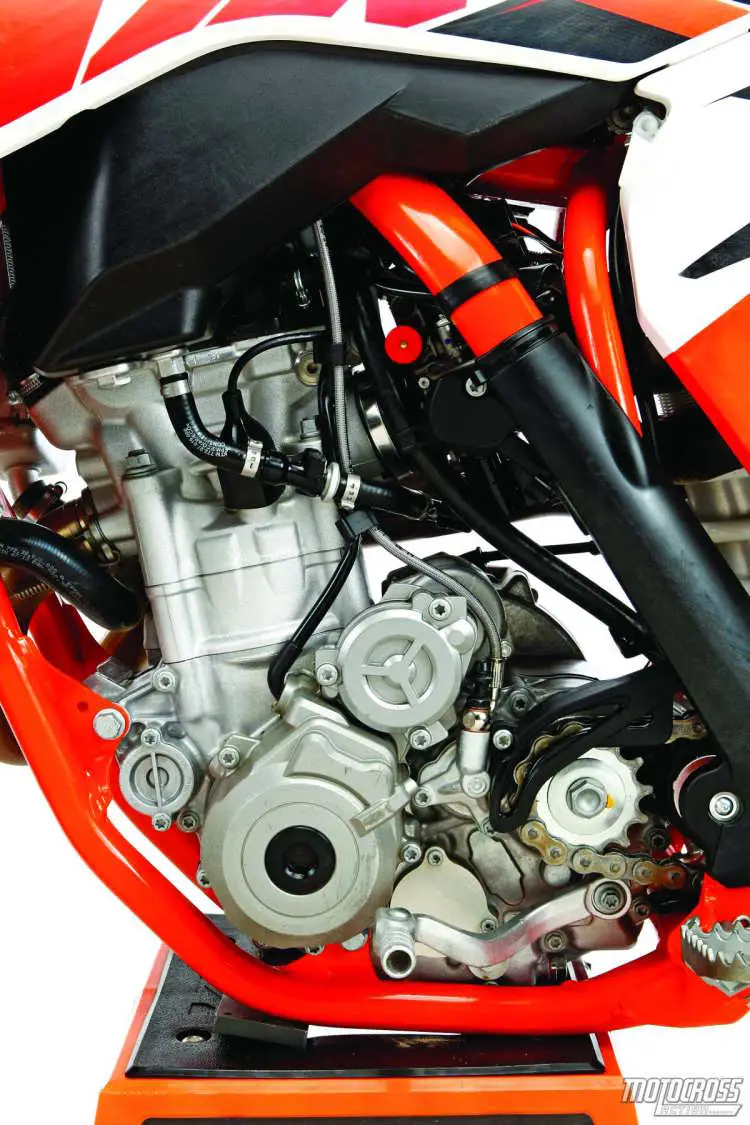
Q: HOW FAST IS THE 2015 KTM 250SXF?
A: It is deceivingly fast. The power builds slowly off idle, ramps up through the midrange and then explodes at high rpm. The KTM 250SXF is a different bike to different riders. Slower riders will never be able to summon the power of the double-overhead camshafts and finger-followers. It requires a high-rpm commitment. And if you don’t commit to keeping it on the pipe, you will find the powerband to be flat and unassuming. The faster the rider, the better he is at carrying speed, and carrying speed is what racing a KTM 250SXF is all about. Only the fastest of the fast ever get the full 42.89 ponies out of the 250SXF.We are impressed by the power output of the KTM engine, but not with its old-school, linear, high-rpm powerband.
Q: HOW DOES THE 2015 KTM 250SXF HANDLE?
A: In the past we have raved about the chromoly steel chassis and balanced handling of the 250SXF, but that compliment always came with a caveat about the forks. The WP bladder forks held the bike back in the handling department. Thankfully, that’s no longer the case. We’re proud to state that the latest iteration of the 250SXF is the best-handling KTM 250 four-stroke ever—once the suspension is set up properly.
The interplay between the steel chassis, 4CS fork and improved rear suspension add up to a sweet combination. Once set up properly, the 250SXF handles like a charm. We also believe that KTM’s decision to reduce offset by moving the front axle helps the bike’s stability in high-speed situations.
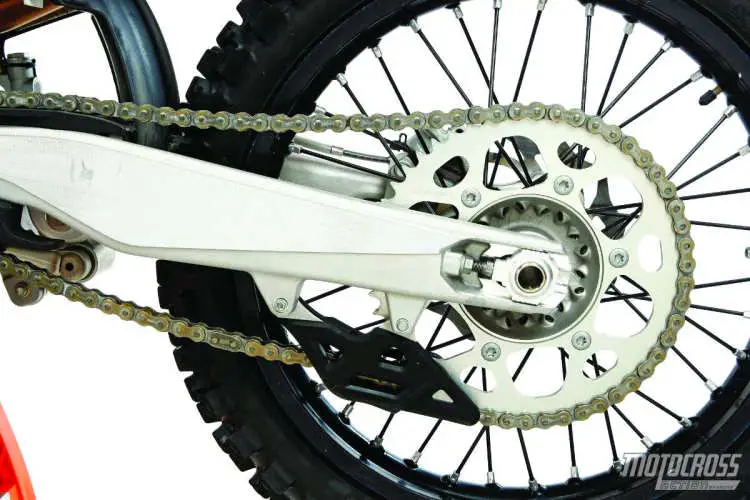
Q: IS THE WP 4CS FORK BETTER THAN THE TRADITIONAL 48MM WP FORK?
A: Yes, but the 4CS fork is quirky and needs some more R&D time. Although not as tuning-intensive as the Showa SFF, Showa SFF TAC, or Kayaba PSF, the 4CS can be finicky to get dialed in.
Here is the process. First, balance out the chassis by carefully selecting the proper race sag and fork height for your weight, speed and track. Second, determine whether you need a stiffer shock spring or not. Most MXA test riders questioned the stiffness of the stock shock spring rate, largely because of a G-out issue. For our tastes, we opted to swap the stock 5.4 Nm shock spring for a 5.7 Nm spring. Obviously, light riders will not need to do this. Third, it’s important to note that the 4CS fork is very sensitive to clicker changes. During the setup process we never encountered mid-stroke harshness that haunted the WP bladder fork. Overall, we’d rate the 4CS fork a C in stock trim, while the old fork was, at best, a D rating.
Q: WHAT AREAS OF THE 2015 KTM 250SXF DID WE ADDRESS?
A: Find satisfaction by making these changes:
(1) Map switch. KTM includes three pre-programmed map settings (unfortunately, you need KTM’s accessory dial, $50, to access these maps). On the dial, Map 1 retards the ignition timing and is best suited for hardpack and slippery surfaces. Map 2 advances ignition timing and provides more hit in soft terrain. This is far and away our favorite map setting, as it livens up the powerband. Maps 3 through 10 are stock but can be reconfigured with a special mapping tool. The KTM 250SXF can run with the coupler unplugged. It will revert back to the stock map setting.
(2) Gearing. Be prepared to carry a quiver of rear sprockets to the track. Less skilled riders went up as many as two teeth, while quasi-fast racers actually preferred taller gearing by dropping a tooth off the rear. We suggest that you try both directions, because they change the personality of the highfalutin engine.
(3) Exhaust. KTM uses a noise-reducing mesh-wire baffle in the muffler. We immediately removed it with needle-nose pliers. Why? The bike is already very quiet, and taking out the baffle improves throttle response. If your bank account is flush with money, then we recommend drop-kicking the stock exhaust for an aftermarket system.
(4) Backfire screen. The backfire screen is integrated into the air-filter cage. It hampers airflow, which mutes throttle response and the engine’s effectiveness. Either remove the cage with side cutters and needle-nose pliers, or spare yourself the hassle by ordering a Twin Air Powerflow kit (www.twinairusa.com, $149.95). The system uses a sturdy aluminum filter cage and includes a fire-retardant air filter.
(5) Quick-disconnect fuel line. The quick-disconnect fuel line popped off the first day we rode the 2015 KTM 250SXF. We’ll chalk it up to a fluke, as it had never happened on other KTM models in the past, but beware of the possibility. Now we always check that the quick disconnects are in place before riding. While you’re at it, clean out the inline fuel filters occasionally.
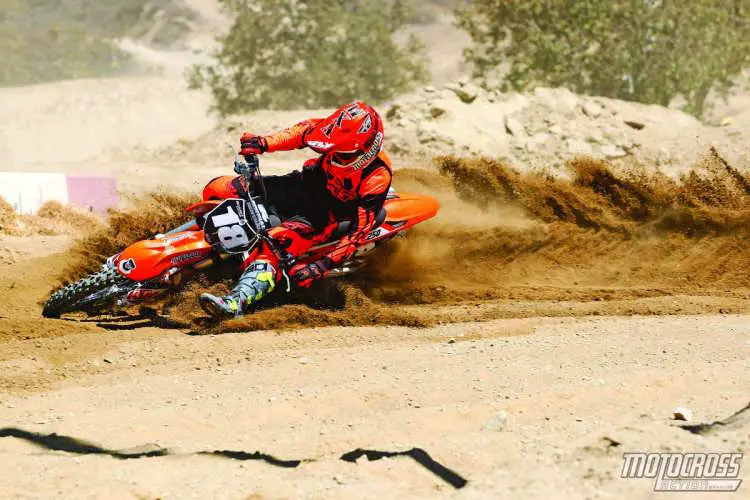
Q: WHAT DID WE HATE?
A: The hate list:
(1) Weight. We love the electric starter, but KTM needs to lose at least 5 pounds of heft to stay competitive.
(2) Frame guards. KTM finally gave the consumer what they wanted—an orange frame like the factory team. Then they covered up the orange paint with black frame guards. Frank Lloyd Wright is probably rolling over in his grave.
(3) Hardware. Torx heads and wood screws don’t belong on a motocross bike. A KTM owner shouldn’t need to wield such strange tools to remove a sprocket or radiator shroud.
(4) Bar mounts. Yes, we know that we whined until KTM mounted taller bars two years ago, but after trying taller aftermarket bars on the 2015 KTM 250SXF, we think they need to go higher again. Fortunately, KTM sells taller bar mounts through their PowerParts division.
Q: WHAT DID WE LIKE?
A: The like list:
(1) Handling. Steel frames might seem like a thing of the past, but they are the future as far as we’re concerned. The 250SXF frame is balanced, absorbent and forgiving, which equates to a neutral-feeling chassis. We love how the 250SXF handles in ruts, and there’s no better-handling bike in flat, hardpack corners.
(2) Clutch. There’s no argument over the effectiveness and ease of KTM’s self-adjusting hydraulic clutch.
(3) Brakes. Other manufacturers have finally answered the call and are outfitting their bikes with 270mm oversize front-brake rotors. KTM is still the king of pucker power.
(4) Aesthetics. In-mold graphics are the way to go. They don’t rip, tear, fade or show signs of wear for a long time. Good stuff.
(5) Rims. We’ve had trouble with the KTM 250SXF silver Excel rims in the past, but the new black Excels withstand abuse from the MXA wrecking crew.
(6) Shifting. The transmission is seamless. The gearbox shifts under a load and off throttle, regardless of clutch use. KTM is one of a few brands to have their transmission configuration on point—although we think the shift lever should be slightly taller.
(7) Suspension setup. In the past, the MXA wrecking crew complained because WP put the exact same valving in the 250SXF, 350SXF and 450SXF. We felt that this “one valving fits all sizes” was a mistake. Obviously, WP now agrees with us, because each 2015 bike gets its own distinct valving. Now they need to find the right valving for each model.
Q: WHAT DO WE REALLY THINK?
A: KTM’s efforts have been rewarded by a massive gain in market share. They spent money on R&D, while their competitors seemed to lose focus. However, we think that KTM needs to start focusing on the power placement of the 250SXF engine, because the Japanese 250s have their power in the sweet spot. That said, the major suspension mods and modest updates everywhere else make the 2015 KTM 250SXF an excellent bike. The question is, do you look good in orange?
MXA KTM 250SXF SETUP SPECS
Are you looking to get the 2015 KTM 250SXF suspension set up? Use these specs as a basis and adjust accordingly.
WP 4CS FORK SETTINGS
WP’s 4CS fork is much better than the old WP bladder fork for several reasons. Number one, the mid-stroke harshness is gone. The clicker adjustments make a noticeable change, particularly on the rebound side. We found comfort by going in on compression and slowing down the rebound slightly. For hardcore racing we recommend this fork setup on the 2015 KTM 250SXF (stock specs are in parentheses):
Spring rate: 0.46 kg/mm
Fork oil height: Most MXA test riders from Novice to Pro, lowere the oil height in 5mm increments to lessen harshness.
Compression: 8 clicks out (15 clicks out)
Rebound: 13 clicks out (15 clicks out)
Fork-leg height: 5mm up
Notes: Fork-leg height is a viable solution to balancing out the fore-to-aft feeling of the 250SXF. On tighter tracks we raised the fork legs to put more emphasis on the front wheel. Also note that achieving harmony between the forks and shock should be your first goal to proper suspension setup. Having one area out of sync will wreak havoc on the handling and suspension performance.
WP SHOCK SETTINGS
KTM lengthened the shock by 4mm, but rear-wheel travel hasn’t changed. The new shock linkage allows the shock to hang lower to compensate. Heavier (170 pounds or more) and faster (top Intermediates and Pros) riders might find that the stock shock spring is too light for their tastes. We installed a 5.6 Nm spring, which improved bottoming resistance and allowed us room to adjust the clicker settings. The WP shock had a tendency to G-out while the bike was under acceleration over braking bumps, so we opted for more high-speed compression damping.
For hardcore racing we recommend this shock setup on the 2015 KTM 250SXF (stock specs are in parentheses):
Spring rate: 5.4 Nm
Race sag: 104mm
Hi-compression: 1-3/4 turns out (2 turns out)
Lo-compression: 19 clicks out (15 clicks out)
Rebound: 13 clicks out (15 clicks out)
Notes: If you’re concerned that the stock 5.4 Nm spring rate is too soft, then be sure to measure the static sag after setting race sag. If static sag is more than 40mm, then it’s imperative to jump up a spring rate. We preferred the 5.7 Nm spring to stock, although we believe that a spring rate in the 5.6 Nm area would work best. Also understand that the 250SXF is very sensitive to race sag.


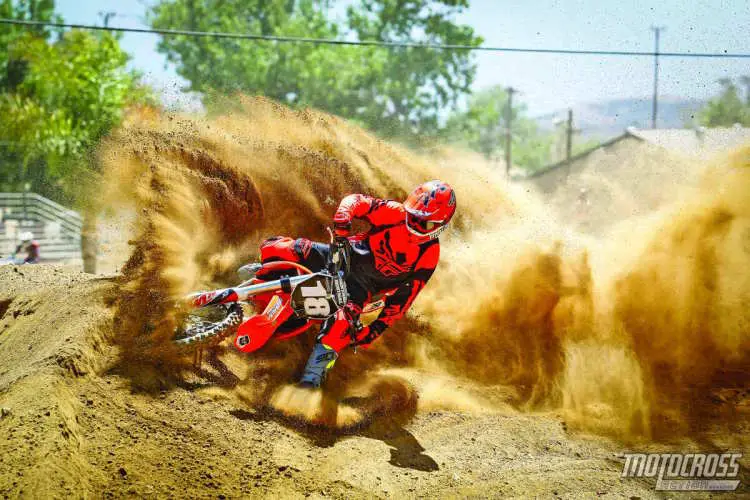




Comments are closed.